|
   
Friday, June 4—Yokohama
As Advertised: Breakfast at Novotel (as described
earlier). Unfortunately, Chie and I are both busy at school all day until late
afternoon.
Morning: Daytime Option B
Afternoon: Daytime Option C
Evening: Come visit our apartment, and then go out to Dinner Option 2
At last we were ready to start really
exploring Yokohama. In one of his several travel guides, “Four Perfect Days in
Yokohama,” Glenn had written:
-
Your time in Yokohama is far too
short, but Chie and I hope that you will see enough of the city to
understand why we love it and to want to come back. There is a Japanese
proverb which roughly translates as “If your family isn’t from Kyoto, even
after three hundred years you’ll never be considered a native. To be an
Edokko (Tokyo native) requires three generations. But three days in Yokohama
are all it takes to become a true Hamakko.” (It’s more concise in Japanese,
but you get the idea.) As a harbor town since its origin, Yokohama has
welcomed people of every nationality, language, and religion from around the
seven seas and poured all of their cultures on top of one bowl of (Chinese)
noodles—still distinct ingredients but combined into one delicious meal.
During your four days, you’ll pass the longevity test and become naturalized
“Hamakko” as well.
Four days indeed didn’t seem like much,
but we tried to pack in as much as we could. At the time, after a couple of
weeks of highly structured and tightly scheduled activities, our self-directed
days in Yokohama seemed very lazy, and that was quite pleasant. Looking back, I
am surprised to see how much we actually did.
This day (like all those that were to
follow) started with breakfast at Denny’s,
which we had ascertained was a much more reasonable option than the
¥2,200 “discount” breakfast at the Novotel.
At some point after breakfast, Barney
and I, accompanied by Sam and Debby, walked the short distance from the Novotel
to the Yokohama Archives of History.
Sam and Debby did not stay long, but Barney and I browsed for a couple of hours,
paying for our gift shop purchases right about noon.
After leaving the museum, we walked a
few blocks farther toward downtown to find a bank where I could get an
additional $100 changed into yen. We settled for a branch of
Sumitomo Mitsui Banking Corporation,
where the exchange was handled smoothly following an extremely methodical
procedure conducted entirely through gestures.
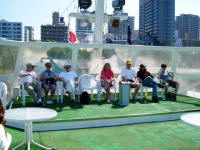 We
returned to Yamashita Park with just time to buy more chocolate mint ice cream bars
from FamilyMart before
joining the rest of the party (except for Dad) for a one-hour
harbor cruise on the Marine
Rouge. Here we all are on the Sky Deck waiting for the departure of
the boat. Left to right: Tom, Joan, Barney, Debby, Sam, Matthew, and Chris
(click to enlarge). We
returned to Yamashita Park with just time to buy more chocolate mint ice cream bars
from FamilyMart before
joining the rest of the party (except for Dad) for a one-hour
harbor cruise on the Marine
Rouge. Here we all are on the Sky Deck waiting for the departure of
the boat. Left to right: Tom, Joan, Barney, Debby, Sam, Matthew, and Chris
(click to enlarge).
When we returned from the cruise around 3:30 p.m., the group disbanded. Barney
and I set off to the other end of Yamashita Park to walk the Kaiko Promenade west
to Landmark Tower, returning through town, rushing a bit because we’d
agreed to meet Tom and Joan at 6 for supper. We got back, almost on time, to find
that Tom had gone to Motomachi to pick up some photos he’d left for processing,
so we had time to rest awhile and soak our weary feet.
When Tom returned, about 6:40, we
headed out to explore Chinatown and find a cheap-but-good restaurant. Glenn had
written:
[A] culinary experience not to be missed is Chinatown,
which is more than just a meal. You can’t go wrong with
any of the restaurants, but you may want to ask at the information center if
you want Mandarin, Sichuan, Shanghai, Hunan, or Taiwanese cuisine. All of
these exist, but you need to find them among the majority of Cantonese
restaurants. One hint is that the food is just as good at smaller
mom-and-pop places on the side streets. They may have shorter menus and less
neon, but you’ll pay a lot less for the same taste than you would at one of
the block-long behemoths on the main street.
If any of us had read this at the time,
we had forgotten it or just ignored it. We ended
up at a restaurant-cum-bakery that was less than a block long and had no neon
(but a fair amount of illumination, as shown below) for an adventure that was fun
and tasty and, for Yokohama, apparently pretty cheap (¥4,858
for two). Although I
have a receipt from the restaurant, it is all in Japanese, and no one remembers
the name of the place (if we ever knew it), nor do I remember much about what we
ate. After puzzling over the menu (which none of us could read, and which
contained very few photos), we told the waiter to just bring us a bunch of
different entrées to share.
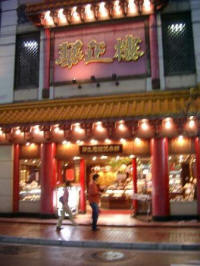 Apparently
I went back the next night, located the restaurant where we had eaten,
and took this rather fuzzy photo. When I sent the photo to Glenn for
identification, he wrote, “As soon as I saw the
photo, I recognized it as Kaseiro, one of the largest and gaudiest restaurants
in Chinatown, on the main street. In 1988, the last time Mother came to Japan
with Dad, Chie’s parents insisted on taking all of
us to dinner there, although we always preferred the less pretentious
mom-and-pop places on the back street. I didn’t
realize you’d been there, but that makes two
generations of Scogginses.” Apparently
I went back the next night, located the restaurant where we had eaten,
and took this rather fuzzy photo. When I sent the photo to Glenn for
identification, he wrote, “As soon as I saw the
photo, I recognized it as Kaseiro, one of the largest and gaudiest restaurants
in Chinatown, on the main street. In 1988, the last time Mother came to Japan
with Dad, Chie’s parents insisted on taking all of
us to dinner there, although we always preferred the less pretentious
mom-and-pop places on the back street. I didn’t
realize you’d been there, but that makes two
generations of Scogginses.”
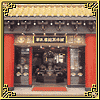 From
other sources I learned that the cuisine at Kaseiro is “Beijing-style.” The
restaurant (which has three locations) also has an elaborate
Web site; at right
is a small daylight photo of the front of the bakery entrance. Evidently Kaseiro
pastries are distributed to various coffee shops around Yokohama as well. From
other sources I learned that the cuisine at Kaseiro is “Beijing-style.” The
restaurant (which has three locations) also has an elaborate
Web site; at right
is a small daylight photo of the front of the bakery entrance. Evidently Kaseiro
pastries are distributed to various coffee shops around Yokohama as well.
Unfortunately, we never had time for
further exploration in Chinatown, about which Glenn had written:
Also within walking distance is Chinatown, the largest in Asia (unless you count China), with
hundreds of restaurants, an impressive temple, lots of shopping, and a series of
elaborate gates at the compass points. The eastern entrance is a few blocks from
the Novotel, with an information office just inside the East Gate. Chinatown is
fun to walk through any time of day: in the morning you can
watch the restaurants opening up and deliveries of exotic food; in the
daytime you can wander around the markets and shops and get the flavor of
Hong Kong, trying to guess the provenance of unrecognizable food; at night
the big restaurants on the main streets shut down, the back alleys are still
hopping with tiny bars and food stalls.
After leaving the restaurant about 8:45
(according to a receipt from the Kaseiro bakery), we wandered through Yamashita Park, enjoying the
nighttime activities (this may have been the evening that we saw a street
entertainer juggling a chain saw), and eventually climbed up to an area at the east end of the park
labeled “World Square” on our maps. This appellation seems to be unknown to
Google or even to Glenn (though I did find a tantalizing aerial view through
Microsoft Virtual Earth™) and I have only vague memories of interesting columns
and cascades of water, along with arrows (in the pavement?) pointing to faraway
places, giving the distance to each. It was too dark to take pictures of the park itself, but
it provided a great vantage point for taking pictures of the illuminated Marine
Tower.
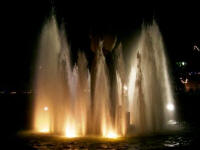 The
Guardian of Water statue in Yamashita Park, presented to the people of Yokohama
by the people of San Diego, California, a Sister City, in May 1960. The fountain
is programmed to create a continuously flowing progression of varying
appearance, and I later made numerous attempts to capture the “perfect” daytime
view (see Day 19 for the result). The
Guardian of Water statue in Yamashita Park, presented to the people of Yokohama
by the people of San Diego, California, a Sister City, in May 1960. The fountain
is programmed to create a continuously flowing progression of varying
appearance, and I later made numerous attempts to capture the “perfect” daytime
view (see Day 19 for the result).
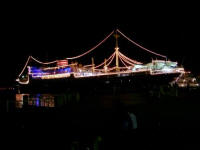 The
festive nighttime illumination of the
Hikawa Maru. The
festive nighttime illumination of the
Hikawa Maru.
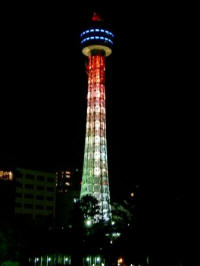 Nighttime
illumination of the Marine Tower. Nighttime
illumination of the Marine Tower.
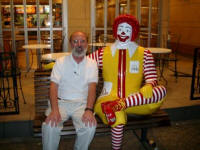 On
our way back to the hotel, I couldn’t resist taking this picture of Barney with
Ronald McDonald in front of the McDonald’s/Denny’s where we often ate. On
our way back to the hotel, I couldn’t resist taking this picture of Barney with
Ronald McDonald in front of the McDonald’s/Denny’s where we often ate. |
